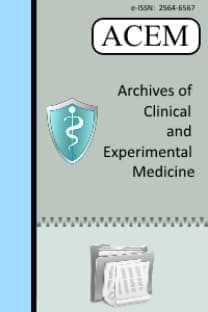Endoskopik olarak tedavi edilemeyen koledok taşlarında koledokoduodenostomi. Hem geleneksel hem de güncel yöntem
ana hepatik kanal eksplorasyonu, koledok, obstrüktif sarılık
Choledochoduodenostomy for failed endoscopic treatment of common bile duct stones. Both traditional and current method
choledochus, common bile duct exploration, obstructive jaundice,
___
- Asad S, Haj Z, Qureshi Z, Gul B, Ahmed S, Khattak IU. Role Of Choledochoduodenostomy Revisited In The Era Of Minimal Invasive Procedures. J Ayub Med Coll Abbottabad. 2019;31:86-9.
- Hungness ES, Soper NJ. Management of common bile duct stones. J Gastrointest Surg. 2006;10:612-9.
- Bektas H, Duzkoylu Y, Cakar E, Buyukasık K, Colak S. Giant choledochal calculosis: surgical treatment. N Am J Med Sci. 2014;6:536-9.
- Berthou JC, Drouard F, Charbonneau P, Moussalier K. Evaluation of laparoscopic management of common bile duct stones in 220 patients. Surg Endosc. 1998;12:16-22.
- Aydın MC, Karahan SR, Kose E. Comparison between laparoscopic and conventional technique in the surgical treatment of choledocholithiasis. Laparosc Endosc Surg Sci. 2020;27:122-9.
- Riedel H. Uber den zungenfoermigen fortastz des rechten lebberlappens und seine pathognostiche bedentung für die, erkrankungen der gallenblose nrbst bemerkungen gallenstein-operationen. Berl Klin Wschr. 1888;25:577–602.
- de Aretxabala X, Bahamondes JC. Choledochoduodenostomy for common bile duct stones. World J Surg. 1998;22:1171-4.
- Konstantakis C, Triantos C, Theopistos V, Theocharis G, Maroulis I, Diamantopoulou G, et al. Recurrence of choledocholithiasis following endoscopic bile duct clearance: Long term results and factors associated with recurrent bile duct stones. World J Gastrointest Endosc. 2017;9:26-33.
- Senthilnathan P, Sharma D, Sabnis SC, Srivatsan Gurumurthy S, Senthil Anand E, Nalankilli VP, et al. Laparoscopic choledochoduodenostomy as a reliable rescue procedure for complicated bile duct stones. Surg Endosc. 2018;32:1828-33.
- Demirel BT, Kekilli M, Onal IK, Parlak E, Disibeyaz S, Kacar S, et al. ERCP experience in patients with choledochoduodenostomy: diagnostic findings and therapeutic management. Surg Endosc. 2011;25:1043-7.
- Okamoto H, Miura K, Itakura J, Fujii H. Current assessment of choledochoduodenostomy: 130 consecutive series. Ann R Coll Surg Engl. 2017;99:545-9.
- Leppard WM, Shary TM, Adams DB, Morgan KA. Choledochoduodenostomy: is it really so bad? J Gastrointest Surg. 2011;15:754-7.
- Srivengadesh G, Kate V, Ananthakrishnan N. Evaluation of long-term results of choledochoduodenostomy for benign biliary obstruction. Trop Gastroenterol. 2003;24:205-7.
- Qadan M, Clarke S, Morrow E, Triadafilopoulos G, Visser B. Sump syndrome as a complication of choledochoduodenostomy. Dig Dis Sci. 2012;57:2011-5.
- Chander J, Mangla V, Vindal A, Lal P, Ramteke VK. Laparoscopic choledochoduodenostomy for biliary stone disease: a single-center 10-year experience. J Laparoendosc Adv Surg Tech A. 2012;22:81-4.
- Khajanchee YS, Cassera MA, Hammill CW, Swanström LL, Hansen PD. Outcomes following laparoscopic choledochoduodenostomy in the management of benign biliary obstruction. J Gastrointest Surg. 2012;16:801-5.
- ISSN: 2564-6567
- Yayın Aralığı: 3
- Başlangıç: 2016
- Yayıncı: -
Mehmet Can AYDIN, Oğuzhan ÖZŞAY, Kağan KARABULUT
Kolorektal kanser cerrahisinde acil cerrahinin çıkarılan lenf nodu sayısına etkisi var mı?
Andrej NİKOLOVSKİ, Kristijan DERVİSHOV, Cemal ULUSOY
İbrahim Ethem CAKCAK, Mert KAPTAN
Plasental invazyon anomalisi olan hastalarda anestezi yönetimi: Tek merkez deneyimi
Güneş Özlem YILDIZ, Canberk ÇETİNEL, Elif MARANGOZ, Özlem Melike EKŞİ, Fidan AYGÜN, Sema KARAKAŞ, Gökhan SERTÇAKACILAR
Aort Kapak Sklerozunun Öngörülmesinde Yeni Hematolojik İnflamatuar Parametrelerin Önemi
